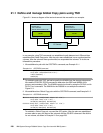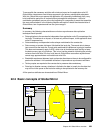
246 IBM System Storage DS6000 Series: Copy Services with IBM System z
22.1 Synchronous and non synchronous data replication
When replicating data over long distances, beyond the 300 km, asynchronous data
replication is the valid approach. This is basically so because with the asynchronous
techniques, the application I/O processing at the local storage disk subsystem (storage
server) remains independent of the process of data transmission to the remote storage disk
subsystem.
Still with the asynchronous data replication techniques, we need to provide additional means
to ensure data consistency at the remote location. It even requires a solution that guarantees
data consistency not only within a single local-remote pair of storage disk subsystems but
also across multiple local and remote storage disk subsystems.
For a given pair of local and remote storage disk subsystems, a time stamp approach leads to
consistent data at the remote storage disk subsystem. Using this approach, and by sorting
the I/Os by their time stamps, the write I/Os can be applied at the remote disk subsystem in
the same sequence as they arrived at the local disk subsystem.
But when the application volumes are spread across multiple storage disk subsystems, this
time stamp concept alone is not sufficient to replicate data and provide data consistency at
the remote site. This additionally requires a Consistency Group concept. z/OS Global Mirror,
formerly known as XRC, is an example of such a solution and utilizes the concept of
Consistency Groups combined with time stamped write I/Os for all involved primary volumes
within a Consistency Group or session. See Part 6, “Global Mirror” on page 265 for more
information regarding z/OS Global Mirror.
In the rest of the present section we discuss how consistent data, that is dependent writes,
are managed either with a synchronous technique like Metro Mirror versus different
asynchronous techniques like Global Copy or Global Mirror.
22.1.1 Synchronous data replication and dependent writes
In normal operations, the nature of synchronous data replication preserves data consistency
for
dependent writes—dependent writes and data consistency are explained in detail in
Section 13.3, “Consistency Group function” on page 136.
Figure 22-1 Synchronous data replication
Primary
A
2C00
Primary
Primary
A
Primary
A1
B1
Storage Disk
Subsystem 1
Storage Disk
Subsystem 2
Replicate
Synchronous
2
SecondaryPrimary
Server
Host
4
3
1
remote site
local site


















